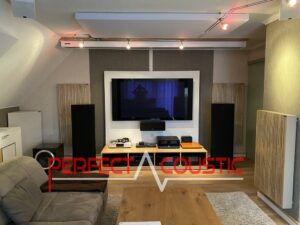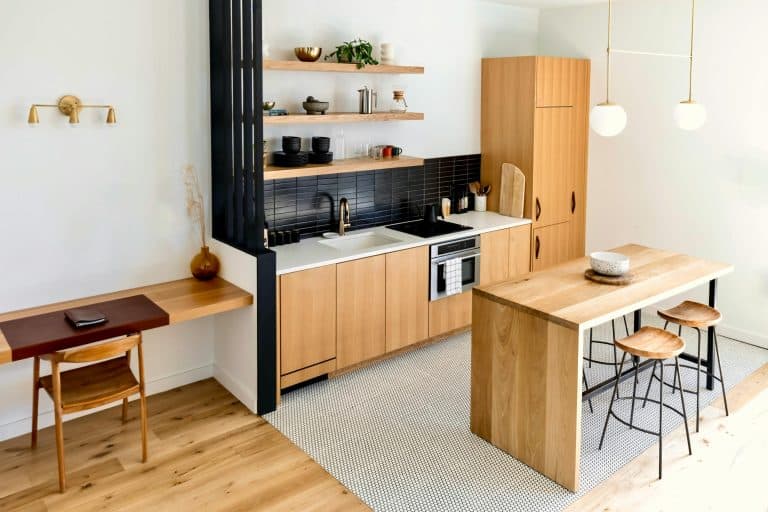Acoustic panels are not just functional; they are an increasingly popular element in modern home design. But why are they becoming a staple in contemporary interiors? The answer lies in their dual capability to enhance both the aesthetic and auditory environment of a space.
Introduction to Acoustic Panels: Why They Matter in Modern Home Design
Acoustic panels are not just functional; they are an increasingly popular element in modern home design. But why are they becoming a staple in contemporary interiors? The answer lies in their dual capability to enhance both the aesthetic and auditory environment of a space.
Aesthetic Appeal: Today’s acoustic panels come in a variety of materials and designs, making them versatile additions to any room’s decor. Whether you are aiming for a minimalist look or a bold statement piece, there’s an acoustic panel that fits every style.
Sound Quality: At its core, the purpose of an acoustic panel is to improve the sound quality of a room. They reduce noise levels, minimize echo, and can significantly improve the clarity of speech and music within a space. This is particularly important in homes with open layouts, where sound tends to travel and reverberate.
Health and Comfort: Beyond aesthetics and sound management, acoustic panels contribute to a more comfortable living environment. By reducing noise pollution, they help create a quieter, more serene home atmosphere that can lead to reduced stress and better overall well-being.
As homes continue to evolve with technology and design trends, the importance of creating a space that looks good and feels good becomes paramount. Acoustic panels address these needs by blending functionality with style, making them a smart choice for modern homeowners looking to elevate their living spaces.
Types of Acoustic Panels: Materials and Styles
Acoustic panels are versatile not only in function but also in form, offering a wide range of materials and styles to fit any interior design scheme. Understanding the different types of acoustic panels can help you choose the right ones for your home, based on both aesthetic preferences and acoustic needs.
Fabric Wrapped Panels: These are among the most popular choices for residential spaces due to their vast range of colors and patterns. Fabric wrapped panels can be customized to match any decor, making them ideal for visible installations where design is just as important as sound absorption.
Wooden Acoustic Panels: Wooden panels are chosen for their natural aesthetic and their excellent sound-dampening properties. Available in various finishes and patterns, wooden acoustic panels add warmth and elegance to a room. They are particularly effective in spaces with modern, rustic, or Scandinavian themes.
Foam Acoustic Panels: Known for their lightweight and cost-effective nature, foam panels are easy to install and come in various shapes and sizes. While not as visually appealing as other types, they can be painted to match the room’s color scheme and are ideal for areas where functionality is more important than appearance.
Perforated Metal Panels: These panels combine durability with a modern look. Perforated metal acoustic panels are resistant to moisture and offer a sleek, industrial aesthetic that works well in contemporary designs.
Acoustic Tiles: Tiles offer modular flexibility and are available in a multitude of designs and textures. They can be arranged in unique patterns to create a feature wall that not only improves room acoustics but also serves as a focal point.
3D Acoustic Panels: For a more avant-garde approach, 3D acoustic panels provide depth and an element of art to any wall. These panels can be used to create visually striking patterns that play with light and shadow while effectively managing sound.
Each material brings its own set of advantages and can be selected based on the specific acoustic and design requirements of your space. By integrating these functional elements into your home’s design, you can enhance both the visual and auditory experience of your living environment.
Designing with Acoustic Panels: Integrating Function and Style
Acoustic panels offer a unique opportunity to enhance both the functionality and the visual appeal of your living spaces. The key to effectively integrating these panels into your home decor lies in thoughtful placement and creative design choices. Here are some strategies for incorporating acoustic panels into various home styles, ensuring they add value both acoustically and aesthetically.
Strategic Placement: Consider the areas of your home where sound quality is crucial, such as home theaters, music rooms, or areas with high foot traffic. Placing acoustic panels on walls or ceilings in these areas can significantly reduce echo and improve sound clarity. For living rooms or open spaces, panels can be used as part of the decor, placed symmetrically or in patterns that complement the existing design.
Custom Designs: Many suppliers offer custom-made acoustic panels that can be tailored to fit specific dimensions and styles. This customization allows for seamless integration into your home’s design, matching everything from the color palette to the overall theme. Whether you’re looking for a bold graphic, a subtle texture, or a specific artistic image, there’s a panel design to meet every aesthetic need.
Dual-Purpose Solutions: Some acoustic panels are designed to serve dual purposes, such as serving as bulletin boards, light fixtures, or even art displays. This multifunctionality is especially useful in smaller spaces or in areas where every piece of decor needs to serve a practical purpose.
Blend with Art and Furniture: Acoustic panels don’t have to stand alone. Incorporate them into wall art installations or behind furniture pieces to enhance their sound-absorbing qualities without them being the focal point. Panels designed with artistic prints can be used as part of a gallery wall, blending in with paintings and photographs.
Use of Textiles: For a softer look, fabric acoustic panels can be coordinated with other textiles in the room, such as curtains, cushions, or upholstery. This approach helps the panels to blend in naturally, making them part of the room’s fabric ensemble.
Layering for Depth: Combine different types of acoustic materials to add depth and interest. For example, using a mix of wood and fabric panels can create a dynamic look that is both functional and visually appealing. This technique works well in eclectic or contemporary settings, where a mix of materials can add to the character of the space.
By considering these design strategies, you can effectively incorporate acoustic panels into your home in a way that enhances both its style and acoustic performance. The result is a living space that looks as good as it sounds, providing a comfortable and aesthetically pleasing environment.
DIY Acoustic Panels: Steps for Home Installation
Installing acoustic panels yourself can be a rewarding project that enhances your home’s aesthetic and auditory environment. Here’s a straightforward guide to help you install acoustic panels effectively:
Materials Needed:
- Acoustic panels
- Measuring tape
- Level
- Pencil
- Drill
- Wall anchors and screws (appropriate for your wall type)
- Adhesive (optional, for non-drill methods)
1. Plan Your Layout
- Measure the Space: Before purchasing panels, measure the wall or ceiling area where you plan to install them. This will help you determine how many panels you need and their optimal placement.
- Design the Pattern: Decide on a layout that not only optimizes sound absorption but also complements your room’s decor. Consider symmetrical patterns for a balanced look or an asymmetrical configuration for a modern aesthetic.
2. Prepare the Area
- Clean the Surface: Ensure that the wall or ceiling is clean and free of dust and debris. This helps the panels adhere better and provides a clean aesthetic.
- Mark the Positions: Using a pencil and level, mark where each panel will go. This step is crucial to keep your installation neat and uniform.
3. Install Mounting Hardware
- Drill Holes: For each panel, drill holes in the wall at the marked positions. Be sure to use the correct drill bit size for your wall anchors.
- Insert Wall Anchors: Tap the wall anchors into the drilled holes if you’re working with drywall or another hollow surface.
4. Mount the Panels
- Attach Panels: Screw the panels into the wall anchors. Alternatively, if you are using an adhesive method (suitable for lighter foam panels), apply the adhesive to the back of each panel and press firmly against the wall.
- Check Alignment: Use a level to check each panel as you go to ensure they are all straight and uniformly aligned.
5. Final Adjustments
- Review the Entire Installation: Step back and look at all the panels from different angles to ensure everything looks aligned and even.
- Sound Test: After installation, do a sound check by playing music or a video to test the acoustics. Listen for any areas that may need additional panels.
6. Decorative Touches
- Add Frames or Borders: If desired, add decorative frames or borders around your panels for a more finished look.
- Coordinate with Decor: Consider adding elements that match or complement the panels, such as curtains, rugs, or art, to integrate them fully into your room’s design.
Installing acoustic panels yourself is an effective way to enhance the acoustical qualities of your space while adding a personal touch to your home’s decor. With the right tools and some planning, you can achieve a professional-looking installation that greatly improves your living environment.
Case Studies: Real-World Examples of Acoustic Panels in Home Design
Acoustic panels are versatile and functional elements that can transform the acoustics and aesthetics of various spaces. Here are a few case studies that demonstrate effective use of acoustic panels in residential settings, showcasing their impact on both sound quality and interior design.
1. Urban Apartment
- Challenge: High noise levels from street traffic and echoing in a small, modern apartment.
- Solution: Installation of fabric-wrapped acoustic panels on key walls in the living area and bedroom.
- Result: Significant reduction in external noise and indoor echoes, with a stylish, modern look that complements the apartment’s contemporary decor.
2. Home Theater Room
- Challenge: Poor sound quality affecting the viewing experience in a dedicated home theater.
- Solution: Strategic placement of thick foam acoustic panels on walls and ceiling, focusing on first reflection points to optimize sound from speakers.
- Result: Enhanced audio clarity and immersive viewing experience, with panels designed to mimic the aesthetics of a traditional cinema.
3. Home Office
- Challenge: Echoes and noise distractions impacting productivity in a home office.
- Solution: Installation of decorative 3D acoustic panels on a feature wall and ceiling to absorb sound and reduce reverberation.
- Result: Improved acoustic comfort that facilitates concentration and productivity, while adding a visually appealing element to the office space.
4. Music Room
- Challenge: Uncontrolled reverberation and sound leakage in a room used for music practice and recording.
- Solution: Use of a combination of wood and fabric acoustic panels to absorb and diffuse sound appropriately.
- Result: Balanced acoustics suitable for recording and practice, with a visually attractive space that inspires creativity.
5. Multi-Purpose Living Space
- Challenge: Need for better sound management in a large, open-plan living area that hosts various activities.
- Solution: Ceiling-mounted acoustic panels and movable acoustic dividers that can be repositioned as needed.
- Result: Flexible sound management that adapts to different uses of the space, maintaining functionality without compromising on style.
These case studies illustrate the transformative effects of acoustic panels, not only in enhancing the sound quality of various home environments but also in contributing to their overall aesthetic appeal. By addressing both practical and visual elements, acoustic panels prove to be an essential feature in modern residential design.









